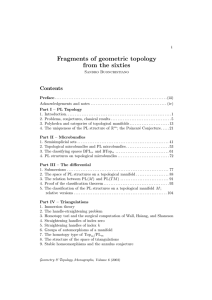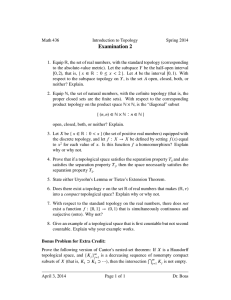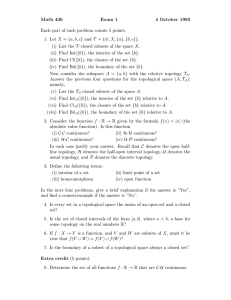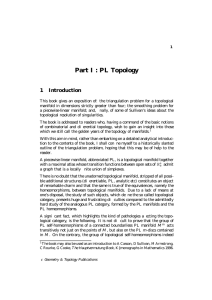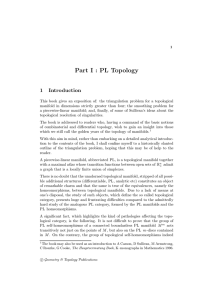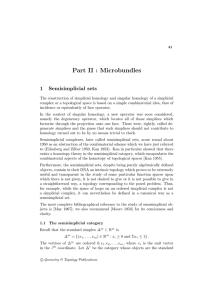Fragments of geometric topology from the sixties Contents
advertisement
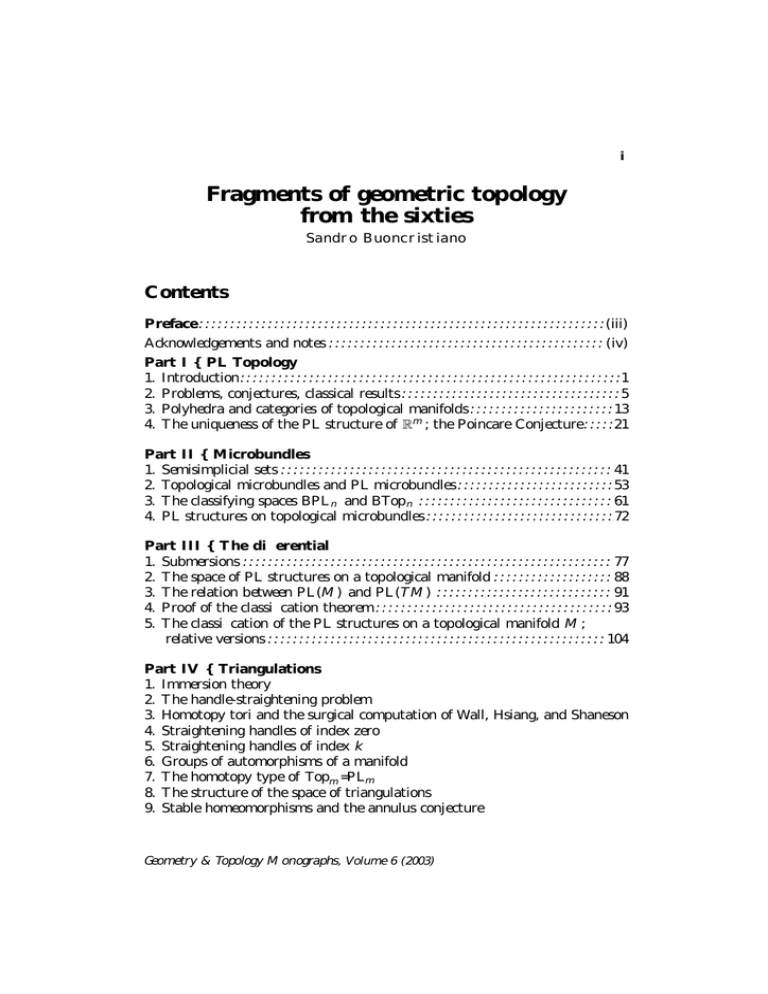
i
Fragments of geometric topology
from the sixties
Sandro Buoncristiano
Contents
Preface : : : : : : : : : : : : : : : : : : : : : : : : : : : : : : : : : : : : : : : : : : : : : : : : : : : : : : : : : : : : : : : : : (iii)
Acknowledgements and notes : : : : : : : : : : : : : : : : : : : : : : : : : : : : : : : : : : : : : : : : : : : : (iv)
Part I { PL Topology
1. Introduction : : : : : : : : : : : : : : : : : : : : : : : : : : : : : : : : : : : : : : : : : : : : : : : : : : : : : : : : : : : : :1
2. Problems, conjectures, classical results : : : : : : : : : : : : : : : : : : : : : : : : : : : : : : : : : : : 5
3. Polyhedra and categories of topological manifolds : : : : : : : : : : : : : : : : : : : : : : : 13
4. The uniqueness of the PL structure of Rm ; the Poincare Conjecture : : : : :21
Part II { Microbundles
1. Semisimplicial sets : : : : : : : : : : : : : : : : : : : : : : : : : : : : : : : : : : : : : : : : : : : : : : : : : : : : : 41
2. Topological microbundles and PL microbundles : : : : : : : : : : : : : : : : : : : : : : : : : 53
3. The classifying spaces BPL n and BTop n : : : : : : : : : : : : : : : : : : : : : : : : : : : : : : : 61
4. PL structures on topological microbundles : : : : : : : : : : : : : : : : : : : : : : : : : : : : : : 72
Part III { The dierential
1. Submersions : : : : : : : : : : : : : : : : : : : : : : : : : : : : : : : : : : : : : : : : : : : : : : : : : : : : : : : : : : : 77
2. The space of PL structures on a topological manifold : : : : : : : : : : : : : : : : : : : 88
3. The relation between PL(M ) and PL(T M ) : : : : : : : : : : : : : : : : : : : : : : : : : : : : 91
4. Proof of the classication theorem : : : : : : : : : : : : : : : : : : : : : : : : : : : : : : : : : : : : : : 93
5. The classication of the PL structures on a topological manifold M ;
relative versions : : : : : : : : : : : : : : : : : : : : : : : : : : : : : : : : : : : : : : : : : : : : : : : : : : : : : : 104
Part IV { Triangulations
1. Immersion theory
2. The handle-straightening problem
3. Homotopy tori and the surgical computation of Wall, Hsiang, and Shaneson
4. Straightening handles of index zero
5. Straightening handles of index k
6. Groups of automorphisms of a manifold
7. The homotopy type of Topm =PLm
8. The structure of the space of triangulations
9. Stable homeomorphisms and the annulus conjecture
Geometry & Topology Monographs, Volume 6 (2003)
ii
Part V { Smoothings
1. The smoothing of a PL manifold
2. Concordance and isotopy
3. The classications of smoothings by means of microbundles
4. Semisimplicial groups associated to smoothing
5. The structure theorem for smoothings
6. The triangulation of a dierentiable manifold
7. On the homotopy groups of PL=O; the Poincare conjecture in dimension
ve
8. Groups of dieomorphisms
9. The rational Pontrjagin classes
Part VI { Pseudomanifolds
1. The dierentiable bordism
2. The bordism of pseudomanifolds
3. The singularities of the join type
4. Sullivan’s theory of the local obstruction to a topological resolution of singularities
Bibliography
Index
Geometry & Topology Monographs, Volume 6 (2003)
iii
Preface
This book presents some of the main themes in the development of the combinatorial topology of high-dimensional manifolds, which took place roughly during
the decade 1960{70 when new ideas and new techniques allowed the discipline
to emerge from a long period of lethargy.
The rst great results came at the beginning of the decade. I am referring
here to the weak Poincare conjecture and to the uniqueness of the PL and
dierentiable structures of Euclidean spaces, which follow from the work of J
Stallings and E C Zeeman. Part I is devoted to these results, with the exception
of the rst two sections, which oer a historical picture of the salient questions
which kept the topologists busy in those days. It should be note that Smale
proved a strong version of the Poincare conjecture also near the beginning of
the decade. Smale’s proof (his h{cobordism theorem) will not be covered in
this book.
The principal theme of the book is the problem of the existence and the uniqueness of triangulations of a topological manifold, which was solved by R Kirby
and L Siebenmann towards the end of the decade.
This topic is treated using the \immersion theory machine" due to Haefliger and
Poenaru. Using this machine the geometric problem is converted into a bundle
lifting problem. The obstructions to lifting are identied and their calculation
is carried out by a geometric method which is known as Handle-Straightening.
The treatment of the Kirby{Siebenmann theory occupies the second, the third
and the fourth part, and requires the introduction of various other topics such
as the theory of microbundles and their classifying spaces and the theory of
immersions and submersions, both in the topological and PL contexts.
The fth part deals with the problem of smoothing PL manifolds, and with
related subjects including the group of dieomorphisms of a dierentiable manifold.
The sixth and last part is devoted to the bordism of pseudomanifolds a topic
which is connected with the representation of homology classes according to
Thom and Steenrod. For the main part it describes some of Sullivan’s ideas on
topological resolution of singularities.
The monograph is necessarily incomplete and fragmentary, for example the
important topics of h{cobordism and surgery are only stated and for these the
reader will have to consult the bibliography. However the book does aim to
present a few of the wide variety of issues which made the decade 1960{70 one
of the richest and most exciting periods in the history of manifold topology.
Geometry & Topology Monographs, Volume 6 (2003)
iv
Acknowledgements
(To be extended)
The short proof of 4.7 in the codimension 3 case, which avoids piping, is hitherto
unpublished. It was found by Zeeman in 1966 and it has been claried for me
by Colin Rourke.
The translation of the original Italian version is by Rosa Antolini.
Note about cross-references
Cross references are of the form Theorem 3.7, which means the theorem in
subsection 3.7 (of the current part) or of the form III.3.7 which means the
results of subsection 3.7 in part III. In general results are unnumbered where
reference to the subsection in which they appear is unambiguous but numbered
within that subsection otherwise. For example Corollary 3.7.2 is the second
corollary within subsection 3.7.
Note about inset material
Some of the material is inset and marked with the symbol H at the start and
N at the end. This material is either of a harder nature or of side interest to
the main theme of the book and can safely be omitted on rst reading.
Notes about bibliographic references and ends of proofs
References to the bibliography are in square brackets, eg [Kan 1955]. Similar
looking references given in round brackets eg (Kan 1955) are for attribution
and do not refer to the bibliography.
The symbol
not given.
is used to indicate either the end of a proof or that a proof is
Geometry & Topology Monographs, Volume 6 (2003)
